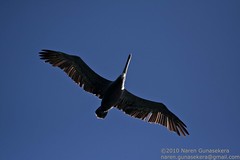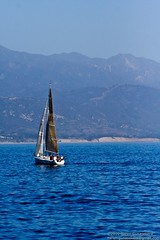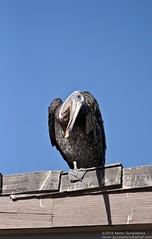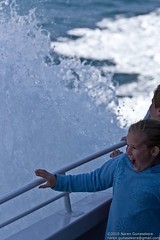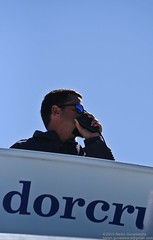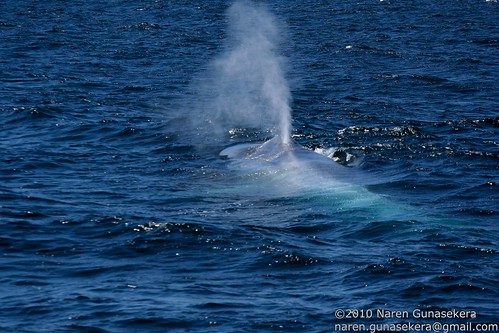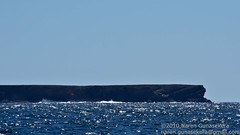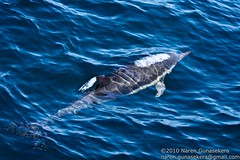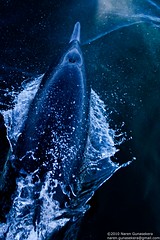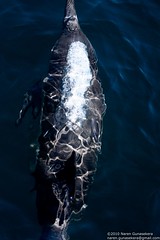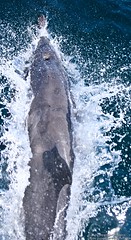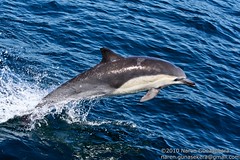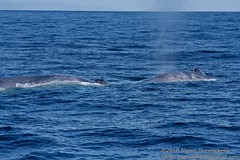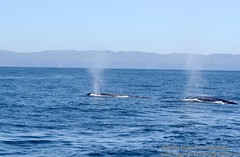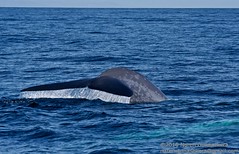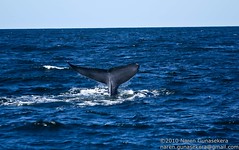Old school beach dive back in California off the shores of Malibu, Dive #6 with Divemaster Dave, Phil, Brian and P from the Pacific Explorers Club.
Escondido Beach: Bottom time – 17 minutes; Depth – 10 meters
27 feet (i.e. 10m) down, this was not exactly how I had envisioned my first California dive, off Escondido beach in Malibu. They had promised me kelp trees and that most definitely was there. I was after all seated right next to one. As I had raised my hand and released the air from my BC and slid under the waves, everything disappeared into a pea soup green haze. Divemaster Dave, Phil, Brian and P sank right next to me, yet when I hit the bottom they were nowhere to be seen.
And boy did I hit bottom. For some reason, it seems that people dive out here in California with much more weights than we did back home. Even taking in the discrepancy of wearing a full wetsuit, hood, etc 27 pounds seemed a bit excessive. As soon as I went negative on my buoyancy, I shot through the water so quickly my sinuses didn’t so much equalize as implode quietly. I’m glad I didn’t do this over the Marianna because I’d still be falling.
Dave’s instructions rolled through my head, 30 seconds down and if we don’t find each other surface. Of course being on the bottom of the Pacific in conditions that seemed reminiscent of the inside of an Blue Whale after a solid rice and curry session wasn't exactly condusive to recalling those instructions. Visibility was down to a couple of feet and everything was pea soup green.
It was with some relief then that ‘Dave’ appeared out of the gloom, fluorescent tank gleaming. As he motioned for me to follow him and we swam off, I assumed we were going to join up with the rest. Yet we continued swimming, at what seemed to me unseemly haste through the kelp. The brown green streamers pushed at us as we weaved through them. If I thought visibility was bad in the open, under the kelp everything went a chocolate brown. All I could see was the fluorescent tank and the faint gleam of Dave’s torch.
We continued swimming through the kelp, at one point ‘Dave’ jerked up over a rock as something zapped him. I took great care to swim further up over the rock (turns out it was some kind of electric ray). After approximately 17 minutes of exploring this area, getting sick of kelp and learning to control my fear as the light kept ebbing and flowing, Dave gave the thumbs up. Ascending through the green and then dark blue waters, we got to the surface, right hand up as a sacrifice to any passing speedboats, we surfaced.
I was intensely curious to find out what had happened to the original plan of all five of us swimming in one line. Maybe because of the visibility ‘Dave’ had decided to split us up. Of course it was with some surprise that I noted when the mask came off at the surface, that my dive buddy was in fact…not Dave.
I could however hear the real Dave in the distance, yelling. Floating on the surface, nervously eying Phil next to me, I couldn’t for the life of me make out what they were yelling. It was only as Phil looked over curiously and wondered aloud what the problem was, that it started to dawn on me….Phil hadn’t stuck to the plan. He’d grabbed me as a dive buddy and decided to go a wandering without waiting for anyone else. Me, being unable to differentiate people at the best of times and most definitely not underwater and in scuba gear, followed as had been instructed. Admittedly I did think the situation strange at the time, but then how does one discuss these things a couple of stories down in the water? Also if it was any consolation, Phil had thought I was P, which if anyone has seen us in real life would realize how laughable a mistake that would be.
As it turns out Dave had, rather un-gratifyingly in my opinion, decided that I must have panicked and drowned Phil (another experienced diver) with me. He had gotten Brian and P to take off their BCs and tanks, tied them to a kelp plant in order to help him look for our bodies. The worst thing is that P didn’t even defend me, pointed out that I’m not a likely person to panic. He was just trying to figure out how to tell the maternal unit without losing vital body parts. 911 was even being dialed as Phil thankfully decided not to explore anymore.
As it turned out, once we surfaced all was well with the world. Universal OK signals were exchanged and we came back to shore in staggered shifts. One thing is getting through the surf at the beginning of the dive was not an issue. But at the end, freezing, tired, disoriented, it’s a hell of a thing to be battered by waves while carrying that tank and wearing those fins. It was not with much dignity that I exited onto the beach. The rest of the dive club members assured me it was standard at the beginning.
Carrying the weights and tank in a wetsuit up PCH was also not the most fun. But it was worth it, despite some of the worst visibility I have seen outside of a drain in Colombo, I mean for all I know I could have had Jaws next to me I wouldn’t have noticed, the dive was an experience. The main lessons being stick to the plan and learning to recognize white people better. I think I’ve had my fill of kelp but I am looking forward to seeing what populates those forests, Channel Islands next stop!
3/31/2010
3/29/2010
Dive Log: Cargo Wreck & Serendip Reef for Advanced Open Water (24/02/2010)
Dive #26 and #27, diving off Mount Lavinia with Colombo Divers, Boatman Ravinda, Divemaster Jehan, buddy Ricardo and Instructor Paris for the second two dives of my Advanced Open Water Course.
Cargo Wreck: Bottom time – 40 minutes; Depth – 31.3 meters
This dive combined my Deep, Multilevel and Wreck dives for my Advanced Certification together. The deep blue over the Cargo beckoned as always as we moored over the site after my briefing about narcosis, wrecks and a diveplan drawn up for the Multilevel dive. This was only second visit to the Cargo and I was excited (there’s my understatement for the year). Roll off and down to the wreck, my descent controlled with my new found buoyancy skills. The usual shoal of fusiliers was missing but as the white speckled ship rose up out of the blue the usual explosion of fish life dazzled.
My old friend the trumpetfish was in attendance but a bit skittish this time as we drifted along the wreck. This being a Deep dive, we bottomed out and 30m as we moved towards the back of the ship. I rather nervously looked around to see if any effects of narcosis would manifest themselves. I figured if Paris or Jehan’s heads suddenly expanded to the size of beach balls or if a Snapper started having a conversation with me that might be a small sign that I was being narced.
Things however remained normal, well as normal as it can be 30m under the sea, swimming under the propeller of a giant sunken cargo ship carrying your own life support system with you. More amazing that normal I guess and the superlatives failed me as I turned on my back as my bubbles streamed past the coral encrusted propeller and we glided under and in between the keel of the ship and the sand.
We took a break for Paris to show me his dive slate with red, blue and green markings to confirm that at these depths these colours looked the same. After a bit more puttering around at 30m oohing and aaahing (figuratively of course) we moved up to 20m per our multilevel dive plan and continued exploring the wreck until our decompression time started ticking down to zero and we took leave of our fishy friends. I surfaced with 82 bar and the Advanced Water Certification having done my first 30m dive. I made a mental note to start reading Diver Down so I didn’t get too cocky.
Serendip Reef: Bottom time – 62 minutes; Depth – 23.1 meters
Don’t let the bottom time shown above fool you. I screwed up on this dive and misread my damn computer which was a bit of a damper end to what was otherwise a brilliant first trip to the outer reef for me. Thus I ended up with something akin to a 20 minute decompression stop at 3m after the last deep dive. It was a rather sobering reminder that I was still very much a beginner diver and I had a fair distance to go with regard to familiarizing myself with my computer and really getting to grips with managing my dive times. I kinda felt bad for Paris, Ricardo and Jehan as they hung around at 3m waiting for my computer to tick down.
Diving Serendip Reef is somewhat akin to swimming in a giant fishtank, albeit one that is over 20 meters deep and full of wondrous life that no fish tank could ever emulate. A small shoal of blue and black surgeonfish swirled as we descended, the white sand contrasting beautifully with the blue, 20m plus visibility water. Specks of coral littered the ocean floor, some alive but some dead (not sure why) Blue Lined Snappers whirled while Gobys peered out from their holes.
The undoubted stars of Serendip however were the Anemone Fish. About 10cm long one defended his Anemone vigorously, swimming up to both Paris and I and chucking at us. This fish had some serious balls, sort of the equivalent of me charging up to a T-Rex and hooting at him (no I don’t have that much balls, show me a real live T-Rex and I’ll need a change of underwear, several changes probably).
After exploring the reef and on our way back I noticed a crab sheltering in the Anemone. Drifting down to investigage, the Anemone Fish was nowhere to be seen. As I moved off however I was treated to the comical sight of the fish poking his head out indignantly from the Anemone with an expression of YOU!!! AGAIN!!!
True characters of the reef, the Anemone fish and it’s a shame that their boldness leads them often to be captured for the aquarium trade, where most die in transport or due to poor care from their erstwhile but often uninformed owners.
Incidentally this was also my last dive with Paris who had to head back to Greece, so I packed him off with a bottle of Old Reserve and an offer to take him on safari to see some leopard if he came back. Here's hoping to see him back in sunny Sri Lanka again!
Cargo Wreck: Bottom time – 40 minutes; Depth – 31.3 meters
This dive combined my Deep, Multilevel and Wreck dives for my Advanced Certification together. The deep blue over the Cargo beckoned as always as we moored over the site after my briefing about narcosis, wrecks and a diveplan drawn up for the Multilevel dive. This was only second visit to the Cargo and I was excited (there’s my understatement for the year). Roll off and down to the wreck, my descent controlled with my new found buoyancy skills. The usual shoal of fusiliers was missing but as the white speckled ship rose up out of the blue the usual explosion of fish life dazzled.
My old friend the trumpetfish was in attendance but a bit skittish this time as we drifted along the wreck. This being a Deep dive, we bottomed out and 30m as we moved towards the back of the ship. I rather nervously looked around to see if any effects of narcosis would manifest themselves. I figured if Paris or Jehan’s heads suddenly expanded to the size of beach balls or if a Snapper started having a conversation with me that might be a small sign that I was being narced.
Things however remained normal, well as normal as it can be 30m under the sea, swimming under the propeller of a giant sunken cargo ship carrying your own life support system with you. More amazing that normal I guess and the superlatives failed me as I turned on my back as my bubbles streamed past the coral encrusted propeller and we glided under and in between the keel of the ship and the sand.
We took a break for Paris to show me his dive slate with red, blue and green markings to confirm that at these depths these colours looked the same. After a bit more puttering around at 30m oohing and aaahing (figuratively of course) we moved up to 20m per our multilevel dive plan and continued exploring the wreck until our decompression time started ticking down to zero and we took leave of our fishy friends. I surfaced with 82 bar and the Advanced Water Certification having done my first 30m dive. I made a mental note to start reading Diver Down so I didn’t get too cocky.
Serendip Reef: Bottom time – 62 minutes; Depth – 23.1 meters
Don’t let the bottom time shown above fool you. I screwed up on this dive and misread my damn computer which was a bit of a damper end to what was otherwise a brilliant first trip to the outer reef for me. Thus I ended up with something akin to a 20 minute decompression stop at 3m after the last deep dive. It was a rather sobering reminder that I was still very much a beginner diver and I had a fair distance to go with regard to familiarizing myself with my computer and really getting to grips with managing my dive times. I kinda felt bad for Paris, Ricardo and Jehan as they hung around at 3m waiting for my computer to tick down.
Diving Serendip Reef is somewhat akin to swimming in a giant fishtank, albeit one that is over 20 meters deep and full of wondrous life that no fish tank could ever emulate. A small shoal of blue and black surgeonfish swirled as we descended, the white sand contrasting beautifully with the blue, 20m plus visibility water. Specks of coral littered the ocean floor, some alive but some dead (not sure why) Blue Lined Snappers whirled while Gobys peered out from their holes.
The undoubted stars of Serendip however were the Anemone Fish. About 10cm long one defended his Anemone vigorously, swimming up to both Paris and I and chucking at us. This fish had some serious balls, sort of the equivalent of me charging up to a T-Rex and hooting at him (no I don’t have that much balls, show me a real live T-Rex and I’ll need a change of underwear, several changes probably).
After exploring the reef and on our way back I noticed a crab sheltering in the Anemone. Drifting down to investigage, the Anemone Fish was nowhere to be seen. As I moved off however I was treated to the comical sight of the fish poking his head out indignantly from the Anemone with an expression of YOU!!! AGAIN!!!
True characters of the reef, the Anemone fish and it’s a shame that their boldness leads them often to be captured for the aquarium trade, where most die in transport or due to poor care from their erstwhile but often uninformed owners.
Incidentally this was also my last dive with Paris who had to head back to Greece, so I packed him off with a bottle of Old Reserve and an offer to take him on safari to see some leopard if he came back. Here's hoping to see him back in sunny Sri Lanka again!
3/24/2010
Dive Log: Palagala (Formosa) for Advanced Open Water (2012/2010)
Dive #25 and #26, diving off Mount Lavinia with Colombo Divers, Boatman Ravinda, Dive buddy K and Instructor Paris for the first two dives of my Advanced Open Water Course.
Palagala: Bottom time – 33 minutes; Depth – 12.8 meters
A word of explanation, well a few words. To quote PADI, the course “helps you increase your confidence and build your scuba skills so you can become more comfortable in the water. This is a great way to get more dives under your belt while continuing to learn under the supervision of your PADI instructor. This course builds on what you’ve learned and develops new capabilities by introducing you to new activities and new ways to have fun scuba diving.”
Flowery words aside my main aim was to do the Peak Performance Buoyancy (PPB) dive, Navigation dive and Deep dive so I could explore the Colombo dive sites to the fullest. To those who have done the basic Open Water, I would highly recommend this option, some of the best sites like the Cargo Wreck, Taprobane East Wreck and the Trug are accessible once you have this certification and the skills and confidence to go to 30m and manage your buoyancy.
The day started with Paris giving me some briefings on the PPB and Nav dive. The latter briefing was enlivened by Paris making me take a bearing to a coconut tree with my compass, draping my head in a towel and making me walk to said coconut tree. The first try was a miserable failure due either to my stupidity or a short term change I the Earth’s magnetic field (I personally think it’s the latter). After a chastisement from Paris and another, more successful try, we boarded the boat and headed out to Palagala which is Colombo Diver's standard training ground. Accompanying us was another beginner diver who was along for the ride, K.
Rolling off, deflating and sinking to the bottom we moved over to a sandy area to practice my PPB skills. I had lost my snorkel at Palagala the day before and had jokingly asked anyone who dove there the next time to take a look see if they could find it. As I settled in knees first to await instruction from Paris, something caught my eye to the right. Taking a quick glance I saw a snorkel lying there, Hmmm….weird…a snork….OH WAIT!!!! Motioning to Paris to hold on with the instructions, I swam over double checked to make sure it was mine (which in retrospect was a bit silly I guess), pumped my fists and jammed my snorkel into my BC (after all it's not everyday the Sea gives something She took back).
This excitement over, we moved on with my skills. The fin pivot and hovering were skills I hadn’t practiced since getting Open Water certified back in December 2008, however with my new-found ideal weight of 4kg, thing went pretty well and Paris was shaking my hand in no time.
The next skill however took a bit of getting used to, basically maneuvering close to the bottom with your reg and mask almost touching the bottom and skimming it. It took me a few minutes of figuring out how to time my inhalations and exhalations but once the skill came the feeling was exhilarating. With my usual over-enthusiasm I skimmed the sand over and over again, taking a break to point out a rather minute, gorgeously black and white spotted nudibranch all by its lonesome on the sand. Paris eventually had to grab me by my fin and shake my hand to make me stop skimming the sand and as we did that, two Remoras twisted by in the murky waters. Both of us immediately stopped what we were doing and starting looking around for a big fish that the Remora’s often accompany, but no matter how much we looked there was no sign of any Rays or Whale Sharks or anything else in the soupy green.
Palagala: Bottom time – 35 minutes; Depth – 13.1 meters
This was the navigation dive and I was a whole lot more nervous about this one, primarily because I wasn’t really good at counting my kicks which was essential for estimating distance (I guess I’ve always been bad at this quantitative business). Visibility had also gotten shittier, about 2m, which rather surprisingly helped me with my navigation.
The navigating a straight line felt a bit awkward because of having to concentrate on my fin-kicks but things got more comfortable with navigating a square pattern. With the low visibility I gave my compass my full attention, trying to follow the lubber line keeping the north arrow aligned in the bezel. Looking up at one stage I was rather surprised (if not a bit dismayed) to come face to face with a Lionfish. We exchanged glances for a second, his somewhat pugnacious and mine somewhat frightened before I finned, inhaled hugely and swam over his menacingly raised fins. Seeing the anchor and anchor line glowing blue in the green murkiness was one of the best feelings of my life, knowing that I wasn’t an absolute moron when it came to navigating with a compass.
The last task was leading Paris and K on a tour of Palagala using ‘natural navigation’, i.e. the features of the reef and the compass. This was admittedly a bit easy because I’d dived Palagala so many times before so was quite familiar with the layout of the reef. Also the reef rather handily runs N-S so adjustments of the bezel of the compass were really not required. It was with the usual tinge of regret that we turned around when K gave the time-out signal for reaching 100 bar and exited the water with him just over 50 bar. Not to blow my own trumpet but I exited with over a 100 bar and had at least another 45 minutes of dive time. Oh heck, I did just blow my own trumpet. I do that sometimes.
Palagala: Bottom time – 33 minutes; Depth – 12.8 meters
A word of explanation, well a few words. To quote PADI, the course “helps you increase your confidence and build your scuba skills so you can become more comfortable in the water. This is a great way to get more dives under your belt while continuing to learn under the supervision of your PADI instructor. This course builds on what you’ve learned and develops new capabilities by introducing you to new activities and new ways to have fun scuba diving.”
Flowery words aside my main aim was to do the Peak Performance Buoyancy (PPB) dive, Navigation dive and Deep dive so I could explore the Colombo dive sites to the fullest. To those who have done the basic Open Water, I would highly recommend this option, some of the best sites like the Cargo Wreck, Taprobane East Wreck and the Trug are accessible once you have this certification and the skills and confidence to go to 30m and manage your buoyancy.
The day started with Paris giving me some briefings on the PPB and Nav dive. The latter briefing was enlivened by Paris making me take a bearing to a coconut tree with my compass, draping my head in a towel and making me walk to said coconut tree. The first try was a miserable failure due either to my stupidity or a short term change I the Earth’s magnetic field (I personally think it’s the latter). After a chastisement from Paris and another, more successful try, we boarded the boat and headed out to Palagala which is Colombo Diver's standard training ground. Accompanying us was another beginner diver who was along for the ride, K.
Rolling off, deflating and sinking to the bottom we moved over to a sandy area to practice my PPB skills. I had lost my snorkel at Palagala the day before and had jokingly asked anyone who dove there the next time to take a look see if they could find it. As I settled in knees first to await instruction from Paris, something caught my eye to the right. Taking a quick glance I saw a snorkel lying there, Hmmm….weird…a snork….OH WAIT!!!! Motioning to Paris to hold on with the instructions, I swam over double checked to make sure it was mine (which in retrospect was a bit silly I guess), pumped my fists and jammed my snorkel into my BC (after all it's not everyday the Sea gives something She took back).
This excitement over, we moved on with my skills. The fin pivot and hovering were skills I hadn’t practiced since getting Open Water certified back in December 2008, however with my new-found ideal weight of 4kg, thing went pretty well and Paris was shaking my hand in no time.
The next skill however took a bit of getting used to, basically maneuvering close to the bottom with your reg and mask almost touching the bottom and skimming it. It took me a few minutes of figuring out how to time my inhalations and exhalations but once the skill came the feeling was exhilarating. With my usual over-enthusiasm I skimmed the sand over and over again, taking a break to point out a rather minute, gorgeously black and white spotted nudibranch all by its lonesome on the sand. Paris eventually had to grab me by my fin and shake my hand to make me stop skimming the sand and as we did that, two Remoras twisted by in the murky waters. Both of us immediately stopped what we were doing and starting looking around for a big fish that the Remora’s often accompany, but no matter how much we looked there was no sign of any Rays or Whale Sharks or anything else in the soupy green.
Palagala: Bottom time – 35 minutes; Depth – 13.1 meters
This was the navigation dive and I was a whole lot more nervous about this one, primarily because I wasn’t really good at counting my kicks which was essential for estimating distance (I guess I’ve always been bad at this quantitative business). Visibility had also gotten shittier, about 2m, which rather surprisingly helped me with my navigation.
The navigating a straight line felt a bit awkward because of having to concentrate on my fin-kicks but things got more comfortable with navigating a square pattern. With the low visibility I gave my compass my full attention, trying to follow the lubber line keeping the north arrow aligned in the bezel. Looking up at one stage I was rather surprised (if not a bit dismayed) to come face to face with a Lionfish. We exchanged glances for a second, his somewhat pugnacious and mine somewhat frightened before I finned, inhaled hugely and swam over his menacingly raised fins. Seeing the anchor and anchor line glowing blue in the green murkiness was one of the best feelings of my life, knowing that I wasn’t an absolute moron when it came to navigating with a compass.
The last task was leading Paris and K on a tour of Palagala using ‘natural navigation’, i.e. the features of the reef and the compass. This was admittedly a bit easy because I’d dived Palagala so many times before so was quite familiar with the layout of the reef. Also the reef rather handily runs N-S so adjustments of the bezel of the compass were really not required. It was with the usual tinge of regret that we turned around when K gave the time-out signal for reaching 100 bar and exited the water with him just over 50 bar. Not to blow my own trumpet but I exited with over a 100 bar and had at least another 45 minutes of dive time. Oh heck, I did just blow my own trumpet. I do that sometimes.
3/22/2010
Dive Log: Palagala (Formosa) and Barracuda (2012/2009)
Dive #23 and #24, diving off Mount Lavinia with my favourite Dive Shop Colombo Divers, Boatman Ravinda, Dive buddy S and Divemaster Jehan.
Palagala: Bottom time – 47 minutes; Depth – 13 meters
This was the dive with the rather unexpected workout. S hadn’t dived for a bit and as we sank to the bottom I figured there might be some issues. The 3m visibility in Palagala takes a bit of getting used to if most of the dives you had done were the blue, 10m+ visibility ones in Matara or Hikkaduwa. And Palagala had freaked me out the first time. As S hit the bottom I winced a bit as both her hands came in contact with the silt and rock at the bottom. Not because of any damage to the corals, since it was mostly rock, but out of concern for her. Scorpion fish are abundant on the reef, amazingly camouflaged and getting stung by one is no picnic. You really want to take a good look before landing on any stony surfaces here (and in the ocean in general).
We settled down for a bit and tried to sort out S’s buoyancy, almost a year out of diving can play hell with these skills and I felt for her as she struggled a bit to sort herself out. Unfortunately she was a bit overweighted and just couldn’t get a hang of either how much air to put into her BC or to get her breathing sorted to maintain her buoyancy. As we swam around I kept a close eye on her and lifted her over the reef when she seemed about to run into it and kept another close eye to make sure she didn’t shoot to the surface. I must say I never thought I would get a bicep workout underwater but there you go...there's always a first!
All in all quite an interesting dive if not for the usual reasons. Trying to help someone sort themselves underwater was a fascinating experience and probably the first time I got an inkling that I might want to pursue a Divemaster course.
Barracuda Reef: Bottom time – 32 minutes; Depth – 23.4 meters
S suffered from a bout of sea sickness during the surface interval and decided not to do the second dive, so J and I sank into the blue waters of Barracuda Reef, where the usual shoal of Pickhandle Barracuda didn’t fail to delight, shiny yellow and grey against the blue backdrop.
Barracuda Reef really is a superlative dive, the blue coral fans peppering the rocks and crevices with innumerable fish and invertebrate life just inviting a diver to stand on their head, exhale and explore. I had decided to reduce my weights by one kilo and thus I was in the throes of neutral buoyancy nirvana. The one kilo reduction meant I could fine tune my buoyancy without any issues and the sense of freedom as I swooped over the reef was exhilarating.
The dive itself was jaw dropping as usual. A lobster lurked under a rock and refused to come out and play while another shrimp hid in a hole in the rock, feelers sticking out, white and stringy. As we swam over an overhang in the rock I noticed what looked like a spotted plate on the sand, underneath the overhang. Exhaling and sinking down gracefully (even if I do say so myself) I was excited to discover an Electric Ray hiding from the daylight hours. Despite Jehan and I both cooing over him, he simply blinked his eyes, ruffled his body into the sand and studiously ignored us. I guess when you pack a voltage from 50-200V you can afford to be a bit nonchalant.
The grande finale to a perfect dive was what appeared to be a little grooming session between a Giant Moray and the most multi-coloured crab I had seen sans being devilled. The Moray gaped at us out of a cylindrical hole in the reef and as I stared at this in fascination, a little movement on the side of his neck attracted me. There was the crab, sylph and coloured in the shades of bright orange, deep red and a midnight black, skittling around the Moray’s neck. The Moray seemed quite chilled out about this with only the occasional shiver as the crab touched a soft spot (I guess). Leaving this rather uncommon tryst to their own devices, we regretfully noted that our decompression time had come to an end and surfaced to be dragged rather ungracefully (in my case not Jehan’s) back onto the boat by Ravinda.
Palagala: Bottom time – 47 minutes; Depth – 13 meters
This was the dive with the rather unexpected workout. S hadn’t dived for a bit and as we sank to the bottom I figured there might be some issues. The 3m visibility in Palagala takes a bit of getting used to if most of the dives you had done were the blue, 10m+ visibility ones in Matara or Hikkaduwa. And Palagala had freaked me out the first time. As S hit the bottom I winced a bit as both her hands came in contact with the silt and rock at the bottom. Not because of any damage to the corals, since it was mostly rock, but out of concern for her. Scorpion fish are abundant on the reef, amazingly camouflaged and getting stung by one is no picnic. You really want to take a good look before landing on any stony surfaces here (and in the ocean in general).
We settled down for a bit and tried to sort out S’s buoyancy, almost a year out of diving can play hell with these skills and I felt for her as she struggled a bit to sort herself out. Unfortunately she was a bit overweighted and just couldn’t get a hang of either how much air to put into her BC or to get her breathing sorted to maintain her buoyancy. As we swam around I kept a close eye on her and lifted her over the reef when she seemed about to run into it and kept another close eye to make sure she didn’t shoot to the surface. I must say I never thought I would get a bicep workout underwater but there you go...there's always a first!
All in all quite an interesting dive if not for the usual reasons. Trying to help someone sort themselves underwater was a fascinating experience and probably the first time I got an inkling that I might want to pursue a Divemaster course.
Barracuda Reef: Bottom time – 32 minutes; Depth – 23.4 meters
S suffered from a bout of sea sickness during the surface interval and decided not to do the second dive, so J and I sank into the blue waters of Barracuda Reef, where the usual shoal of Pickhandle Barracuda didn’t fail to delight, shiny yellow and grey against the blue backdrop.
Barracuda Reef really is a superlative dive, the blue coral fans peppering the rocks and crevices with innumerable fish and invertebrate life just inviting a diver to stand on their head, exhale and explore. I had decided to reduce my weights by one kilo and thus I was in the throes of neutral buoyancy nirvana. The one kilo reduction meant I could fine tune my buoyancy without any issues and the sense of freedom as I swooped over the reef was exhilarating.
The dive itself was jaw dropping as usual. A lobster lurked under a rock and refused to come out and play while another shrimp hid in a hole in the rock, feelers sticking out, white and stringy. As we swam over an overhang in the rock I noticed what looked like a spotted plate on the sand, underneath the overhang. Exhaling and sinking down gracefully (even if I do say so myself) I was excited to discover an Electric Ray hiding from the daylight hours. Despite Jehan and I both cooing over him, he simply blinked his eyes, ruffled his body into the sand and studiously ignored us. I guess when you pack a voltage from 50-200V you can afford to be a bit nonchalant.
The grande finale to a perfect dive was what appeared to be a little grooming session between a Giant Moray and the most multi-coloured crab I had seen sans being devilled. The Moray gaped at us out of a cylindrical hole in the reef and as I stared at this in fascination, a little movement on the side of his neck attracted me. There was the crab, sylph and coloured in the shades of bright orange, deep red and a midnight black, skittling around the Moray’s neck. The Moray seemed quite chilled out about this with only the occasional shiver as the crab touched a soft spot (I guess). Leaving this rather uncommon tryst to their own devices, we regretfully noted that our decompression time had come to an end and surfaced to be dragged rather ungracefully (in my case not Jehan’s) back onto the boat by Ravinda.
3/18/2010
Dive Log: Hatare Gala and Meda Gala (27/12/2009)
Dive #11 and #12, diving off Bentota with Thambapanni Dive Center.
Hatare Gala: Bottom time – 31 minutes; Depth – 22 meters
I needed to get out of the hotel, Taj Exotica, despite the nice rooms was vastly overpriced for what you got, especially in terms of food, but we had come there for a short break before the end of 2009 none the wiser. With the lunacy dripping out of the back of my skull I called reception and requested they put me in touch with a dive center. Another phone call and I was booked for bright and early in the morning for a two tank dive.
Then next day a gentleman named Sri who looked liked he was built out of a tree trunk picked me up from the reception and took me to get my equipment sorted out (me being too lazy to bring my BCD and Reg to Bentota). Geared up and meeting another couple who were going to be doing their last two training dives for their Open Water License we headed to the dock. Heading out to the dive sites was an interesting experience as we had to breach the Bentota River, the green-brown, white tipped waters roiling as the fresh water of the river met the saline solution of the sea.
A relatively short ride and we were ready to roll off. My divemaster was an old grizzled Lankan hand, having had many stints at commercial diving in the Middle East under his belt. The back roll was a bit disconcerting since it had been over a year since I’d done a back roll into the water and six months since my last dives in California.
Gurgling down to the bottom, I was greeted by gigantic rock structures amongst white sands. I believe this site is listed on Dive Sri Lanka as the Canoe Rock site because the pictures look pretty similar to what I saw…which I guess is not saying much given the vastness of the ocean. Snappers and fusiliers flitted in and out of the rock as I adjusted to having a BC on and breathing through my mouth again. Equalizing a bit more and coming to terms with the mask pressing against my face, we headed off around the rocks.
The biggest moment of excitement on the dive was when a huge grey shape loomed out of the murk, visibility being a somewhat mediocre 10 meters (what I’m spoiled?!). For a moment a mixture of fear and excitement gripped me as I thought SHARK! But marginally disappointingly it turned out to be a rather good sized Seer fish alternatively known as an Indo-Pacific King Mackerel. Not quite a shark but still exciting stuff.
Medagala: Bottom time – 35 minutes; Depth – 20 meters
The second dive was somewhat similar to the first. More big rocks and sand. I believe this may be the site called the South Reef on Dive Sri Lanka or possibly even vice versa with the previous dive.
The Bump-head Parrotfish were the most obvious of the initial sites as we bottomed out at 20 meters, regulators hissing reassuringly. The fish were feeding heavily on the coral encrusting the rocks and the crunch, crunch of their heavy beaks breaking into the calcium was a constant background symphony to the dive. The big fish seemed to like me in Bentota because a few minutes into the dive a Great Barracuda joined us for a bit. Not wanting to frighten him off I tried to breath as discreetly as possible but on the first bubbles escaping from my reg, the Barracuda (actually a juvenile so relatively small) inched closer in curiosity, silvery black against the black backdrop of the hulking rocks.
After the Barracuda took his/her leave the dive was relatively quiet apart from a couple of giant lobsters pirouetting in a cave. Tried to peer under the ledge into the cave, I realized that I still had a long way to go with handling my neutral buoyancy as I bounced up and down probably scaring the heck out of the lobsters. Back on the boat as we headed back into the Bentota River, the waters looking a lot surlier with the high tide, my divemaster gave me a spiel on how delicious lobsters are freshly caught from the ocean.
Hatare Gala: Bottom time – 31 minutes; Depth – 22 meters
I needed to get out of the hotel, Taj Exotica, despite the nice rooms was vastly overpriced for what you got, especially in terms of food, but we had come there for a short break before the end of 2009 none the wiser. With the lunacy dripping out of the back of my skull I called reception and requested they put me in touch with a dive center. Another phone call and I was booked for bright and early in the morning for a two tank dive.
Then next day a gentleman named Sri who looked liked he was built out of a tree trunk picked me up from the reception and took me to get my equipment sorted out (me being too lazy to bring my BCD and Reg to Bentota). Geared up and meeting another couple who were going to be doing their last two training dives for their Open Water License we headed to the dock. Heading out to the dive sites was an interesting experience as we had to breach the Bentota River, the green-brown, white tipped waters roiling as the fresh water of the river met the saline solution of the sea.
A relatively short ride and we were ready to roll off. My divemaster was an old grizzled Lankan hand, having had many stints at commercial diving in the Middle East under his belt. The back roll was a bit disconcerting since it had been over a year since I’d done a back roll into the water and six months since my last dives in California.
Gurgling down to the bottom, I was greeted by gigantic rock structures amongst white sands. I believe this site is listed on Dive Sri Lanka as the Canoe Rock site because the pictures look pretty similar to what I saw…which I guess is not saying much given the vastness of the ocean. Snappers and fusiliers flitted in and out of the rock as I adjusted to having a BC on and breathing through my mouth again. Equalizing a bit more and coming to terms with the mask pressing against my face, we headed off around the rocks.
The biggest moment of excitement on the dive was when a huge grey shape loomed out of the murk, visibility being a somewhat mediocre 10 meters (what I’m spoiled?!). For a moment a mixture of fear and excitement gripped me as I thought SHARK! But marginally disappointingly it turned out to be a rather good sized Seer fish alternatively known as an Indo-Pacific King Mackerel. Not quite a shark but still exciting stuff.
Medagala: Bottom time – 35 minutes; Depth – 20 meters
The second dive was somewhat similar to the first. More big rocks and sand. I believe this may be the site called the South Reef on Dive Sri Lanka or possibly even vice versa with the previous dive.
The Bump-head Parrotfish were the most obvious of the initial sites as we bottomed out at 20 meters, regulators hissing reassuringly. The fish were feeding heavily on the coral encrusting the rocks and the crunch, crunch of their heavy beaks breaking into the calcium was a constant background symphony to the dive. The big fish seemed to like me in Bentota because a few minutes into the dive a Great Barracuda joined us for a bit. Not wanting to frighten him off I tried to breath as discreetly as possible but on the first bubbles escaping from my reg, the Barracuda (actually a juvenile so relatively small) inched closer in curiosity, silvery black against the black backdrop of the hulking rocks.
After the Barracuda took his/her leave the dive was relatively quiet apart from a couple of giant lobsters pirouetting in a cave. Tried to peer under the ledge into the cave, I realized that I still had a long way to go with handling my neutral buoyancy as I bounced up and down probably scaring the heck out of the lobsters. Back on the boat as we headed back into the Bentota River, the waters looking a lot surlier with the high tide, my divemaster gave me a spiel on how delicious lobsters are freshly caught from the ocean.
As I dried off in the hotel, I looked at the menu.
Rs.3,000 for a lobster
For that price I would expect the lobster to serenade me before dinner as well so I stuck to an overpriced piece of slipper that masqueraded as a burger from the room service menu.
Give Taj Exotica a miss if you are ever in that area, if you like value for money that is.
Give Taj Exotica a miss if you are ever in that area, if you like value for money that is.
3/15/2010
Jungle Tide
By John Still was one of the most influential books I have ever read, and one that I go back to every now and then. The copy I have is old, yellow and brittle, its spine worn from hundreds of reads many miles from home, in the cold of London and the blaze of heat that was California. Jungle Tide was one of the books that really solidified my love for the wild and the dry zone.
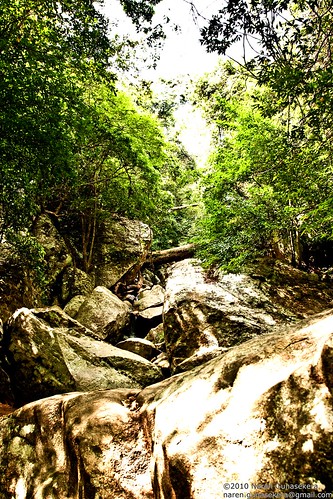
Still writes beautifully of a variety of aspects of Sri Lanka's wilds, from the mountain forests, Sri Pada, the Wanni, Veddhas and my personal favourite, the Dry Zone jungles and wildlife. His anectodes are many ranging from stalking buffaloes, elephant graveyards, the devil bird, jungle charms to heal centipede bites and even losing the Governer of Ceylon (as Sri Lanka was known then) in the jungle. The charming recounting of his pet bears and leopards always made me want to keep either of the two, well mostly a leopard as a pet when I was kid. Possibly a bit unrealistic living in the middle of Colombo!

The poetic nature of the book and the overall theme of a Jungle Tide conquering all, made a huge impression on me as a youth and I strongly suggest any and all who have an interest in Sri Lanka and its wilds to read this book to truly understand what an amazing natural heritage we have and need to protect for ourselves and our future generations.

"Visions of a regimented earth where birds only sing by request are to me so much more distasteful than the age-old struggle with the jungle tide, that I rejoice in an outlook that to the commercial utiliser of applied science horribly pessimistic. I do not think man will win final victory over the jungle; but rather that the battle will go on in the future as it has in the past with alternating victories on either side, and with the tide of the jungle ever ready to rise and flow over civilisation whenever it grow too proud to keep on learning...or when it gets tired of exerting willpower...or when it makes mistakes" - John Still, 1930


Still writes beautifully of a variety of aspects of Sri Lanka's wilds, from the mountain forests, Sri Pada, the Wanni, Veddhas and my personal favourite, the Dry Zone jungles and wildlife. His anectodes are many ranging from stalking buffaloes, elephant graveyards, the devil bird, jungle charms to heal centipede bites and even losing the Governer of Ceylon (as Sri Lanka was known then) in the jungle. The charming recounting of his pet bears and leopards always made me want to keep either of the two, well mostly a leopard as a pet when I was kid. Possibly a bit unrealistic living in the middle of Colombo!

The poetic nature of the book and the overall theme of a Jungle Tide conquering all, made a huge impression on me as a youth and I strongly suggest any and all who have an interest in Sri Lanka and its wilds to read this book to truly understand what an amazing natural heritage we have and need to protect for ourselves and our future generations.

"Visions of a regimented earth where birds only sing by request are to me so much more distasteful than the age-old struggle with the jungle tide, that I rejoice in an outlook that to the commercial utiliser of applied science horribly pessimistic. I do not think man will win final victory over the jungle; but rather that the battle will go on in the future as it has in the past with alternating victories on either side, and with the tide of the jungle ever ready to rise and flow over civilisation whenever it grow too proud to keep on learning...or when it gets tired of exerting willpower...or when it makes mistakes" - John Still, 1930

3/09/2010
There she blows! (Californian version)
This was a trip taken back in the day when I used to call California home, a bright and early morning in October 2007 when Nalin and I headed out to see some Blue Whales (the largest animal that has ever existed) off the coast of Santa Barbara. Fingers crossed if March goes as planned I should have a Sri Lankan version of this up soon!
There she blows again…
It may have been a side effect of waking up so early on a Saturday morning that a decidedly odd version of that infamous Sixpence none the Richer was playing in my head. It’s been awfully long time since I’ve woken up late on a Saturday in my own bed…and in fact it looks like it’s going to be awhile until I get to in the near future.
The throaty growl outside indicated Nalin had turned up in his Z, about 15 minutes early which was very un-Sri Lankan off him. We scarfed down some McDees breakfast while I gave my camera equipment a final look see.
Body…check
4 gig card (would prove to be horrendously slow)…check
1 gig card (high speed)…check
1 gig card (high speed)…at Praveen’s…I reckon I should start renting him rental for that.
2 gig card (high speed)…forget…dammit
zip lock bag jury rig (necessary to keep spray off my lovely L lens)…check
batteries (useless performance for some reason)…check
And it was off to Santa Barbara to meet Suma, and two other people whose names escape me. The Condor Express which was to take us out into the Channel and traverse Santa Cruz island was an impressive sight in the early morning light. I yawned, chewed on 10 altoids to keep my sore throat at bay and climbed on board. We all, being the chandyias that we are decided to go to the bow and stand in the full might of the wind as the high speed Express tried to prove exactly how high speed it was.
L-R: Early morning pelican; Hold on tight; Sailboats in the harbour; Buoy; Extra from Saving Nemo
It was exhilarating, if a bit chilly. The boat bounced for a few kilometers through some moderate chop and the back kicking spray somehow miraculously missed us and drenched a rather surprised girl next to us to the bone. Laughing at her (discreetly) and sympathizing with our friends, who almost immediately felt dizzy and had to sit down, Nalin and I enjoyed clearing our lungs and lowering our core body temperatures. After awhile we were both a bit cold and bored, but neither of course wanted to admit this to the other. So we stood and froze until finally the guide yelled out “there she blows.”
L-R: Kids enjoying the spray; Guide giving us the low down on the whales
Now if I was a blue whale and I heard that yelled out, I would most probably lift my skirts around my ankles and skooted (or the whale equivalent of that) and with good cause because for the last couple of decades that cry was usually followed by a booming sound and a curious burning itch followed I’m going to guess by incomprehensible pain as the harpoon grenade exploded in the whale. It is somewhat scary to think that we puny humans almost managed to wipe out the largest creature that has ever lived on the planet in the course of a few score years, from around 300,000 prewhaling to less than 5,000 now.
There she blows!
The first whale we saw was a pretty young though, and thankfully must not have experienced the niceties of the whaling industry. The experience of watching a whale is almost like that of elephants in Yala. The whale breathes on the surface for awhile, entertaining us with its spouts and then with a graceful arch of its back and a goodbye wave of its tailfins goes down deep. We would then wait out the whale until he surfaces anywhere from a few 100 feet to half a mile yonder. The sort of like the safari jeeps in Yala the boat is gunned to where the whale is languishing and the cycle is repeated….well…maybe in hindsight it not very similar to watching elephants in Yala.
Leaving the young female behind we moved on as a bunch of Dall’s porpoises came by to check the boat out and left without posing for my camera and then we did a perambulation around the island of Santa Cruz. I’m not sure if anybody out there is as geeky as me, but I was quietly excited to see this island close up because of a book I loved as kid, the Island of the Blue Dolphins in which the main character was marooned on one of the Channel Islands. The book was actually based on a true story and looking at that island I could only think that being marooned on such a god forsaken place would suck…there was not a single tree to be seen. I personally like palm trees to be present if I get marooned on an island.
L-R: Forbidding islands; Kelp in the shallows; bird crap spattered rocks
The trip back to shore was dramatic to say the least. We were initially joined by what seemed like a couple of hundred dolphins which took a break from lunching on some bait fish to come leaping over to play with the boat. I’ve decided to petition whoever is in charge of reincarnations that once I die, I want to be reborn as a dolphin. Seriously it just looks like they have so much fun. The speed at which they flew through and out of the water was breathtaking and with such little body movement. Nalin and I couldn’t keep our cameras straight and I almost beamed a little kid in the head taking what seemed like a couple of hundred pictures of the dolphins.
Dolphins at play
As if that wasn’t enough excitement there turned up not one, not two but three blue whales. And these guys were not juveniles. That was one of the few times that I have felt true awe in my life. The majesty was just unexplainable, all we could see was the grey backs as they came up to breath but the sheer size was inescapable. Their bodies were so huge their backs formed light blue pools as they were a meter or so below sea level. In fact the light blue appearance of their backs due to these mobile 'pools' is what gave the whale their 'Blue' name.
Two males cruising
There were two males fighting over a female, the female leading and the males following (thus proving that even with a brain the size of a small car, common sense does not prevail). All three gave us a fascinating show with their habit of arching their backs excessively during their preliminary breaths and then on their penultimate breath heading down with a languorous wave of their huge flippers. It truly was a sight I felt privileged to see and that’s no hyperbole.
Whale Flukes
As the boat turned around and started heading back to shore, one of the giant males gave a langorous wave with its huge fins as it sounded, water pouring off the fins as it went down into the depths of the Pacific.
Wave Goodbye
3/01/2010
A hard to catch lizard (Moneragala Chronicles)
For more info on what the Moneragala Chronicles are click here.
The Katussa fell from the tree in front of me. As we had taken a general interest in the gamut of wildlife present in the Moneragala area, I walked over to take a closer look. I was a bit taken aback to note that the lizard had apparently injured itself when it fell and had a bright red head. I was even more taken aback when the bright red head turned white. Calling Nuwan over to have a closer look, I noted that it was a bit nervous, scattering through the leaves as I came closer.
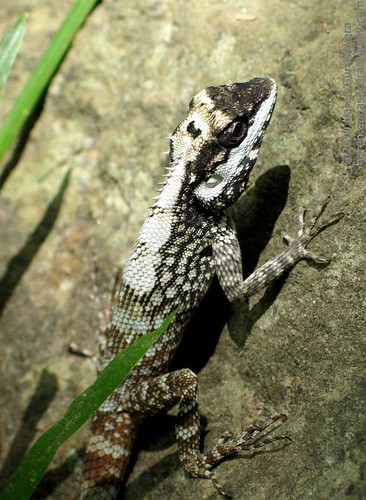
Nuwan quickly identified the katussa as a somewhat rare lizard known as Calotes ceylonensis, which also goes by the much more lyrical common name of the Painted-Lip Lizard. Notably this species is only found in Sri Lanka and is one of the five lizards of the Calotes genus which is endemic to our emerald isle (as a wildlife geek, I rejoice in such facts as this).
We hatched a hasty plan to capture the creature to record its details for posterity. What followed was something like out of a Monty Python skit, Nuwan clambering on a thorny vine as the lizard evaded all attempts at capture. Eventually he climbed around 10 feet up a tree, balanced precariously on a vine and managed to scare the lizard towards me while I affected my best attempt at a rugby tackle (a gentle rugby tackle considering it was a lizard that we were capturing) in order to pin the lizard down. Note that no harm came to Mr. Ceylonensis as we were extremely careful throughout the exercise. In fact more harm came to us than to the lizard.
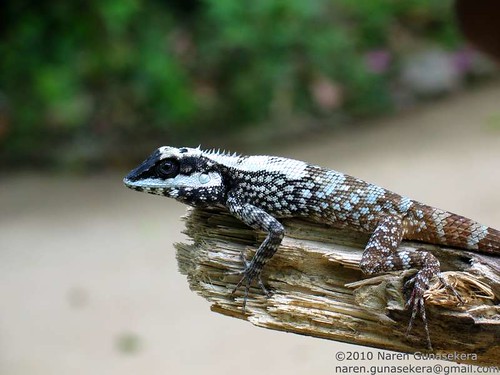
In the end we took a plethora of pictures with the help of the Vedemahattaya's son before releasing the relieved lizard back into the wild. One more member of Sri Lanka's reptile fauna had been recorded and photographed by us. Steve Irwin, here we come.
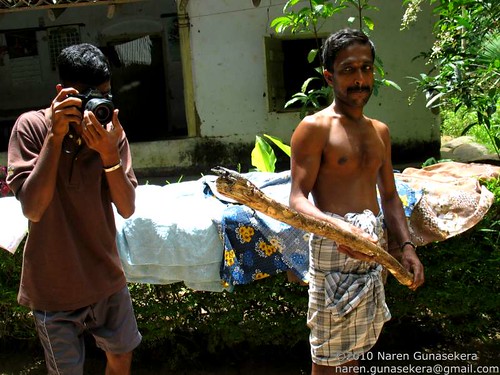
The Katussa fell from the tree in front of me. As we had taken a general interest in the gamut of wildlife present in the Moneragala area, I walked over to take a closer look. I was a bit taken aback to note that the lizard had apparently injured itself when it fell and had a bright red head. I was even more taken aback when the bright red head turned white. Calling Nuwan over to have a closer look, I noted that it was a bit nervous, scattering through the leaves as I came closer.

Nuwan quickly identified the katussa as a somewhat rare lizard known as Calotes ceylonensis, which also goes by the much more lyrical common name of the Painted-Lip Lizard. Notably this species is only found in Sri Lanka and is one of the five lizards of the Calotes genus which is endemic to our emerald isle (as a wildlife geek, I rejoice in such facts as this).
We hatched a hasty plan to capture the creature to record its details for posterity. What followed was something like out of a Monty Python skit, Nuwan clambering on a thorny vine as the lizard evaded all attempts at capture. Eventually he climbed around 10 feet up a tree, balanced precariously on a vine and managed to scare the lizard towards me while I affected my best attempt at a rugby tackle (a gentle rugby tackle considering it was a lizard that we were capturing) in order to pin the lizard down. Note that no harm came to Mr. Ceylonensis as we were extremely careful throughout the exercise. In fact more harm came to us than to the lizard.

In the end we took a plethora of pictures with the help of the Vedemahattaya's son before releasing the relieved lizard back into the wild. One more member of Sri Lanka's reptile fauna had been recorded and photographed by us. Steve Irwin, here we come.

Subscribe to:
Comments (Atom)
